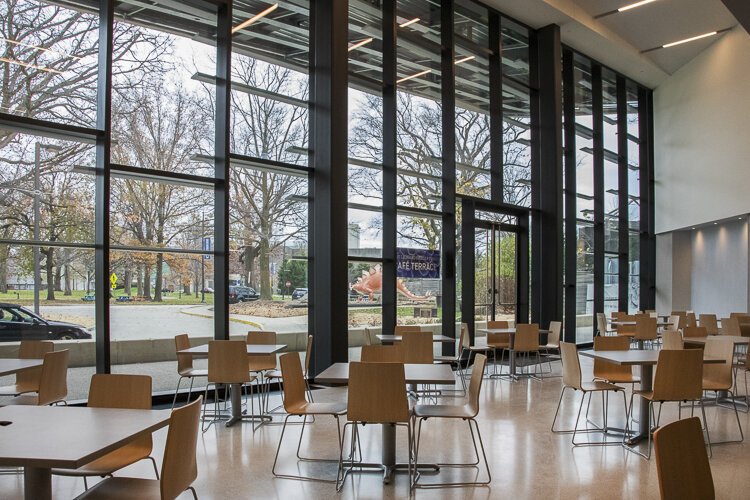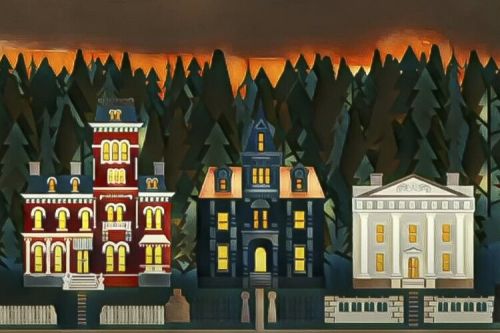Design + Build
Preservation celebration: Historic preservation projects honored by Restoration Society, AIA
The Cleveland Restoration Society and the American Institute of Architects will host the annual Celebration of Preservation to honor local restoration projects in Northeast Ohio. Read about some of the honorees here.
Tudor Arms Hotel: A swanky gothic revival cornerstone in University Circle
Cleveland Masterworks: The 1930s Tudor Arms building. designed by Frank Meade, has seen a rich history, from its origins as the exclusive Cleveland Club, to a hotel and nightlife hotspot, to the current modern-day hotel.
Tour the past: County opens Veteran’s Memorial Bridge lower deck, hosts talk about future plans
The subway level of the Veterans Memorial Bridge will be open this weekend for tours and a discussion about creating a public "Low-Line Park" on the level that was closed in 1954.
Warner & Swasey Observatory: A hilltop gem turned architectural relic
Cleveland Masterworks: In 1919 Worcester Warner and Ambrose Swasey built an observatory on a hill in East Cleveland, intending to use it for their own interests. In 1920, the partners in Warner & Swasey Company decided to gift the land and the observatory to Case School of Applied Science. For 60 years the facility was used for groundbreaking astronomical research before the city's light pollution forced it to close. Today, the observatory sits abandoned, decayed, and vandalized—a ghost of its former glory.
The Caxton Building: A haven for artists and entrepreneurs for 120 years
Cleveland Masterworks: Cleveland architect Frank Seymour Barnum designed the 1903 Caxton Building for a group of successful entrepreneurs who wanted to accommodate the needs of printers and artists. With its Romanesque design with great architectural detail, reinforced concrete floors, large windows, and its signature water tower perched on the roof, the Caxton continues to be a small business haven to this day.
The Little Blue Cottage and Forest Hill: Real estate offices of Rockefeller development
Cleveland Masterworks: The Forest Hill Historic District in Cleveland Heights is one of the first planned communities in the country, with homes designed by Andrew J. Thomas for John D. Rockefeller's development. Now the Abeyton Realty office needs repairs.
New purpose: Longfellow Elementary gets new life as affordable housing
CMSD's 1924 Longfellow Elementary School in Collinwood, designed by Cleveland schools architect Walter McCornack, was saved from demolition by the Cleveland Restoration Society and has been repurposed as affordable senior housing.
Harold Burdick: Eclectic architect in the Heights
Cleveland Masterworks: Harold Burdick was known for designing 28 houses in Shaker Heights and worked on the design of the Federal Reserve building. But he might be most noted for the futuristic design of his own home in Cleveland Heights.
Woodhill Homes project earns $10 million HUD boost
The ongoing Woodhill Homes development project in the Buckeye-Woodhill neighborhood—a six-phase, six-year $250 million development project by Cuyahoga Metropolitan Housing Authority (CMHA), the City of Cleveland, and Boston-based The Community Builders (TCB)—just received a boost through a $10 million HUD Choice Neighborhoods Supplemental Funding Grant.
Lutheran Metropolitan Ministry is using solar power to house the homeless
Lutheran Metropolitan Ministry and PadSmart have just launched a pilot program to build energy efficient solar-powered homes to provide those experiencing homelessness with affordable a new affordable housing option.
The Garfield Building: Home to two banks, a jeweler, apartments, and a top-notch steak house
Cleveland Masterworks: Designed by Henry Ives Cobb and constructed in 1893, the Garfield Building on Euclid Avenue and Bond Street was designed with banking facilities in the basement level. Today, the building hosts apartments and the Marble Room restaurant.
Alfred Hoyt Granger: Designed grand homes for elite Cleveland Heights, Bratenahl residents
Cleveland Masterworks: Although architect Alfred Hoyt Granger only was in Cleveland and in partnership with Frank B. Meade for a short time, he made an impression in the late 1800s and early 1900s with his designs on Overlook Road in Cleveland Heights and on Lake Shore Boulevard in Bratenahl.
New life given to Cleveland Public Library’s 95-year-old West Park branch
Cleveland Public Library officials and the community celebrated the renovated and restored historical West Park Branch this past Saturday when the 95-year-old building, designed by Walker and Weeks, reopened to patrons after nearly 10 months of work.
Building on hope: I_You Design Lab aims to give the displaced a sense of home
When his classmates in architecture school were dreaming of building skyscrapers and office towers, Sai Sindondit was dreaming of creating affordable, sustainable, and functional permanent communities to house displaced populations—from the homeless to refugees and disaster victims. With the launch of I_You Design Lab, he has started to fulfill that dream.
Continued evolution: Natural History Museum will reveal renovations, new exhibits this week
The Cleveland Museum of Natural History has unveiled the most recent renovations in its $150 million transformation project that will update and expand its both its offerings and physical square footage.
St. Hubert’s Episcopal Church: All are Welcome at this historic house of worship
Cleveland Masterworks: Originally built in 1893 on the banks of the Chagrin River, St. Hubert's Episcopal Church served wealthy Clevelanders on retreat at Kirtland's Little Mountain. The church has moved several times over the past 130 years, but continues to welcome everybody at its current Kirtland Hills location.
Reliving history: Business consultant recreates Millionaires' Row through video
Business consultant Jarrett Bayne has used historic photos from the Cleveland Public Library's photo collection to create a 14-minute YouTube video illustrating what it would have looked like to walk down Euclid Avenue, Millionaires' Row, 150 years ago.
The Allen-Sullivan House: Euclid Avenue Grande Dame takes its final bow
The Allen-Sullivan House, one of the last houses remaining on Millionaires' Row before it was torn down in 2021, has a colorful history of owners and uses. Architectural historian Angelina Bair chronicles its history and its fate.
MAGNET’s new Midtown manufacturing hub aims to create jobs, grow local economy
Last week, MAGNET moved into its new headquarters, the Manufacturing Innovation, Technology & Job Center, that will connect people to training and jobs, increase manufacturing innovation, and transform Northeast Ohio factories with advanced technologies.
Sweet journey: Fear’s Confections celebrates birthday with chocolate, local art, scavenger hunt
Confection lovers from across Northeast Ohio are invited to drop in to Fear's Confections this weekend to experience the hand-made sweets and nerdy, rockabilly vibe that define the shop that offers “sweets to die for” and participate in a neighborhood scavenger hunt.












